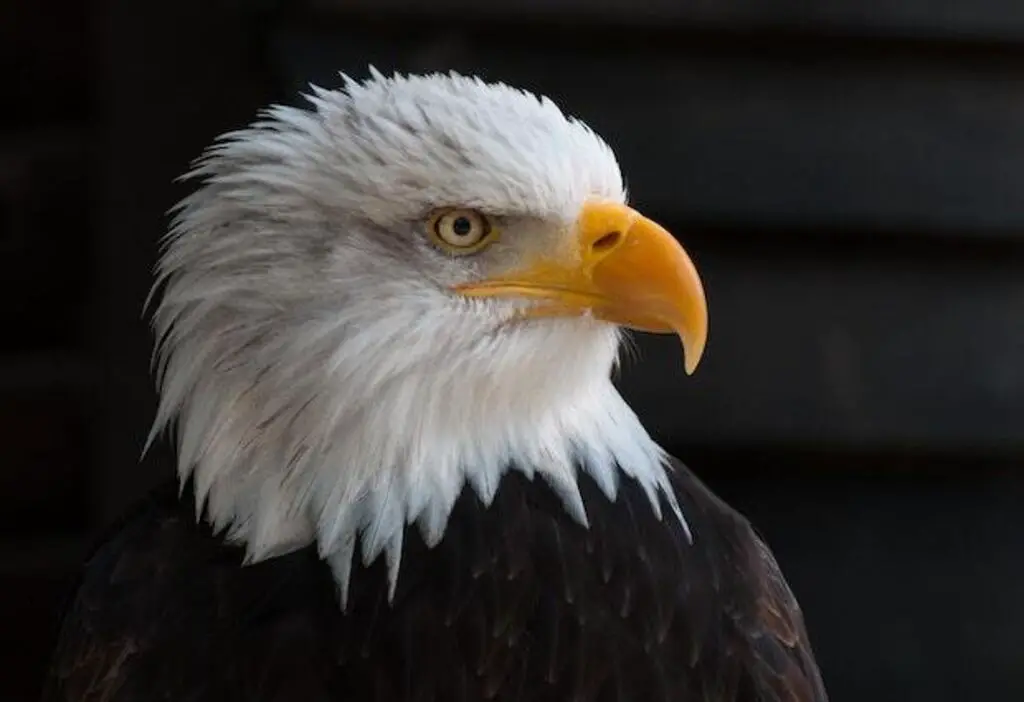Did you know that only a small percentage of female bald eagles have a white head? According to recent research, approximately 5-10% of female bald eagles exhibit this distinct plumage trait.
This fascinating phenomenon has intrigued scientists and wildlife enthusiasts alike, sparking numerous studies to understand the underlying factors responsible for this variation.
In this article, we will delve into the physical characteristics of bald eagles, with a particular focus on their plumage.
By examining the role of plumage in bald eagles and the significance of the white head, we aim to shed light on the genetic and environmental factors that contribute to this unique attribute.
Additionally, we will explore the importance of individual variation and the role of photography in capturing and appreciating the diverse plumage of bald eagles.
So, let us embark on a scientific journey into the world of female bald eagles and their captivating white heads.
Table of Contents [show]
Key Takeaways
- Only 5-10% of female bald eagles have a white head
- The white head feathers of bald eagles serve as a key identifying trait and play a role in mating behaviors
- The white head helps bald eagles blend in with their surroundings and signal maturity and readiness to mate
- Understanding the development of the white head provides insights into the biology and behavior of bald eagles

Do Female Bald Eagles Have A White Head
Yes, female bald eagles have a white head, just like their male counterparts. However, it takes about five years for their head and tail feathers to fully turn white, while juveniles have a combination of brown and white plumage.
This distinct white head helps in distinguishing adult bald eagles from younger ones and is a remarkable characteristic of this iconic raptor.
The Physical Characteristics of Bald Eagles
Female bald eagles exhibit the same physical characteristics as their male counterparts, including a distinctive white head. Understanding the feather structure of bald eagles helps explain this characteristic.
The white feathers on their heads are not actually white, but rather colorless, due to the lack of pigment. These feathers are made up of a complex structure of keratin, a protein found in bird feathers.
Natural selection and adaptation play a role in the development of this white head coloration.
The white feathers help bald eagles blend in with their surroundings, making them less visible to prey and potential predators.
Additionally, the white head serves as a signal to other eagles, indicating maturity and readiness to mate.
Understanding the role of plumage in bald eagles is crucial in comprehending their overall biology and behavior.
Understanding the Role of Plumage in Bald Eagles
The plumage of adult bald eagles undergoes significant changes as they mature, with the head and tail feathers transitioning from a mottled brown to a striking white coloration.
These changes are a result of molt patterns and melanin production. Molt patterns refer to the shedding and replacement of feathers, which occurs annually in bald eagles.
During the molting process, the brown feathers are gradually replaced by new white feathers.
Melanin production, a pigment responsible for the brown coloration, decreases as eagles age, leading to the development of the iconic white head and tail feathers.
This transition in plumage is one of the key characteristics that distinguish adult bald eagles from their immature counterparts.
Understanding the significance of the white head in bald eagles is crucial in comprehending their behavior and life history.
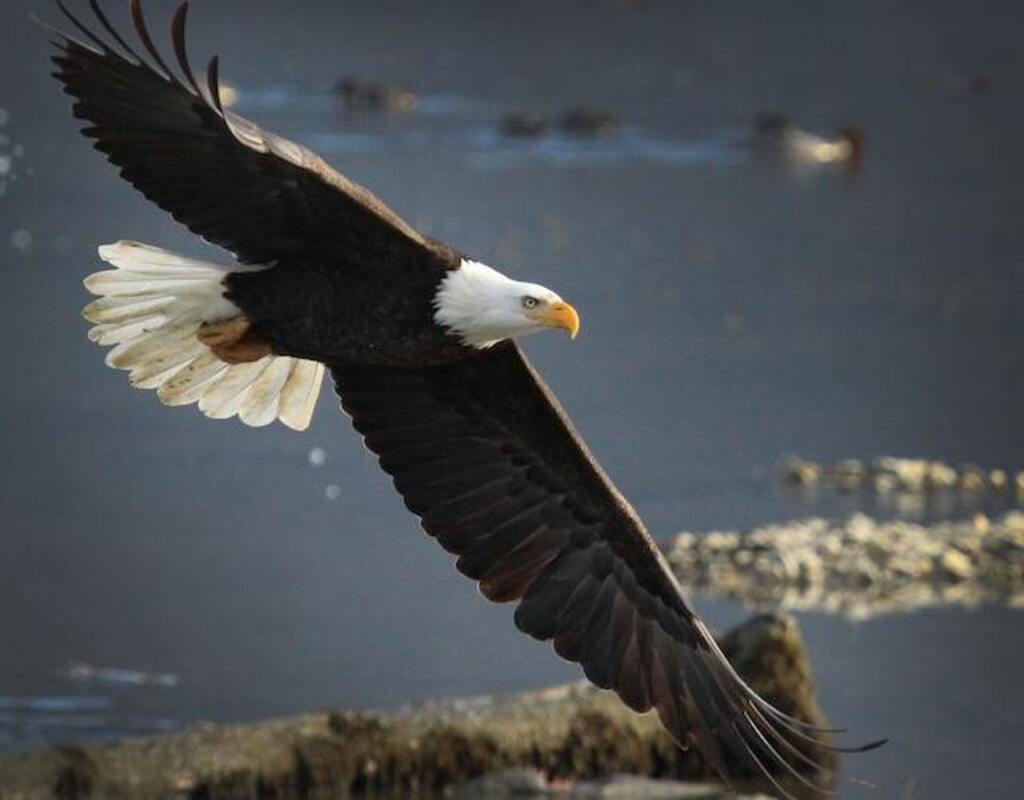
The Significance of the White Head in Bald Eagles
The white head of bald eagles holds significant symbolism and cultural importance. It is often associated with strength, power, and freedom, making the bald eagle a national symbol of the United States.
Additionally, the white head plays a crucial role in mating and courtship displays, as it is an important feature used to attract potential mates and establish dominance within the species.
Studies have shown that males with brighter and more distinct white heads are more successful in attracting females during courtship rituals.
Symbolism and Cultural Importance
Symbolism and cultural importance surround the majestic bald eagle, with its iconic white head serving as a powerful visual representation.
This distinctive feature holds great significance in various cultures and societies, symbolizing strength, freedom, and national pride.
Understanding plumage in bald eagles is essential to comprehend the deeper meaning associated with the white head.
- The white head represents purity and wisdom, capturing the essence of this revered bird.
- It symbolizes the bald eagle’s maturity and leadership qualities within its habitat.
- The white head also signifies the bird’s status as an apex predator, embodying power and dominance.
- In Native American cultures, the white head is considered sacred and is believed to possess spiritual qualities.
- Additionally, the white head has become a prominent emblem of national identity, representing the United States and its ideals of liberty and freedom.
This cultural significance of the bald eagle’s white head extends beyond aesthetics, reflecting the bird’s role in society and its symbolic value.
Understanding the importance of this feature provides a foundation for exploring the mating and courtship displays exhibited by these remarkable birds.
Mating and Courtship Displays
Mating and courtship displays in bald eagles are intricate and elaborate, showcasing the species’ remarkable communication and bonding rituals.
These displays serve to establish and strengthen pair bonds between male and female eagles.
Mating rituals typically begin with aerial displays, where the birds soar together, performing synchronized flights and acrobatic maneuvers.
This impressive aerial dance not only demonstrates the eagles’ physical abilities but also acts as a visual display of their strength and agility.
Courtship behavior includes vocalizations, such as high-pitched calls and screeches, which serve as signals to attract potential mates.
Additionally, eagles engage in courtship feeding, where the male offers food to the female as a sign of his ability to provide for their future offspring.
Understanding these mating and courtship behaviors provides valuable insights into the reproductive strategies of bald eagles.
Exploring the genetic factors that drive these behaviors further enhances our knowledge of this magnificent species.
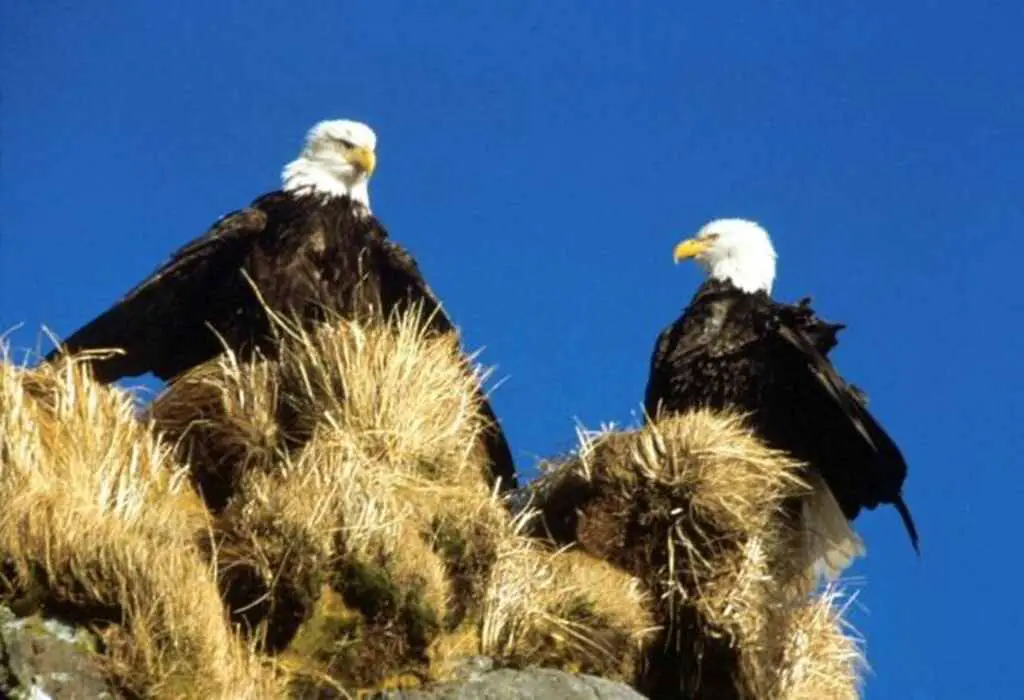
Exploring the Genetic Factors
The role of genetics in plumage coloration in bald eagles is a topic of great interest among researchers.
By studying the inheritance patterns and variations in plumage coloration, scientists can gain insights into the genetic factors that contribute to the development of the white head in bald eagles.
Understanding these genetic mechanisms can provide valuable information for conservation efforts and help unravel the complex interplay between genes and phenotypes in this iconic species.
The Role of Genetics in Plumage Coloration
Genetics play a significant role in determining the plumage coloration of female bald eagles, as they inherit genes that influence the development of their distinctive white head feathers.
The inheritance patterns of these genes can be complex, with multiple genes interacting to produce the final phenotype.
Environmental influences can also play a role in the expression of these genes, affecting the intensity of the white head feathers.
Research has shown that female bald eagles with a higher genetic predisposition for white head feathers tend to have brighter and more prominent plumage, while those with a lower genetic predisposition may have more muted colors.
Understanding the genetic factors involved in plumage coloration can help researchers gain insights into the evolutionary history and conservation strategies for this iconic bird species.
Transitioning into the subsequent section, the inheritance patterns and variations of these genes further contribute to the fascinating diversity of bald eagle plumage.
Inheritance Patterns and Variations
The role of genetics in plumage coloration is a complex and fascinating subject. Inheritance patterns play a significant role in determining the coloration of an individual’s plumage.
These patterns can vary depending on the species and can be influenced by multiple genes. For example, in bald eagles, the gene responsible for white head coloration is inherited in a dominant manner.
This means that if an individual has at least one copy of the gene, they will have a white head. However, there can still be variations in the intensity of the white coloration due to other genetic factors.
It is important to note that while genetics play a crucial role in determining plumage coloration, cultural symbolism can also influence how certain colors are perceived and valued.
Transitioning to the next section, environmental factors also contribute to the overall plumage coloration of birds.
Environmental Factors That Influence Plumage Coloration
Environmental factors such as diet, habitat, and exposure to pollutants can influence the coloration of plumage in birds.
The coloration patterns observed in birds’ plumage are often a result of the interaction between genetic factors and environmental influences.
For example, the presence of certain pigments in the diet can affect the intensity and hue of plumage color.
Additionally, the availability of specific habitats, such as areas with abundant food sources or suitable breeding sites, can influence the development and maintenance of plumage coloration.
Furthermore, exposure to pollutants, such as heavy metals or chemicals, can lead to alterations in plumage coloration.
Understanding the environmental factors that influence plumage coloration in birds is crucial for assessing the health and ecological status of bird populations.
Transitioning into the subsequent section about ‘age and maturity in bald eagles’, these environmental factors can interact with the genetic factors to shape the plumage coloration patterns as birds mature and age.
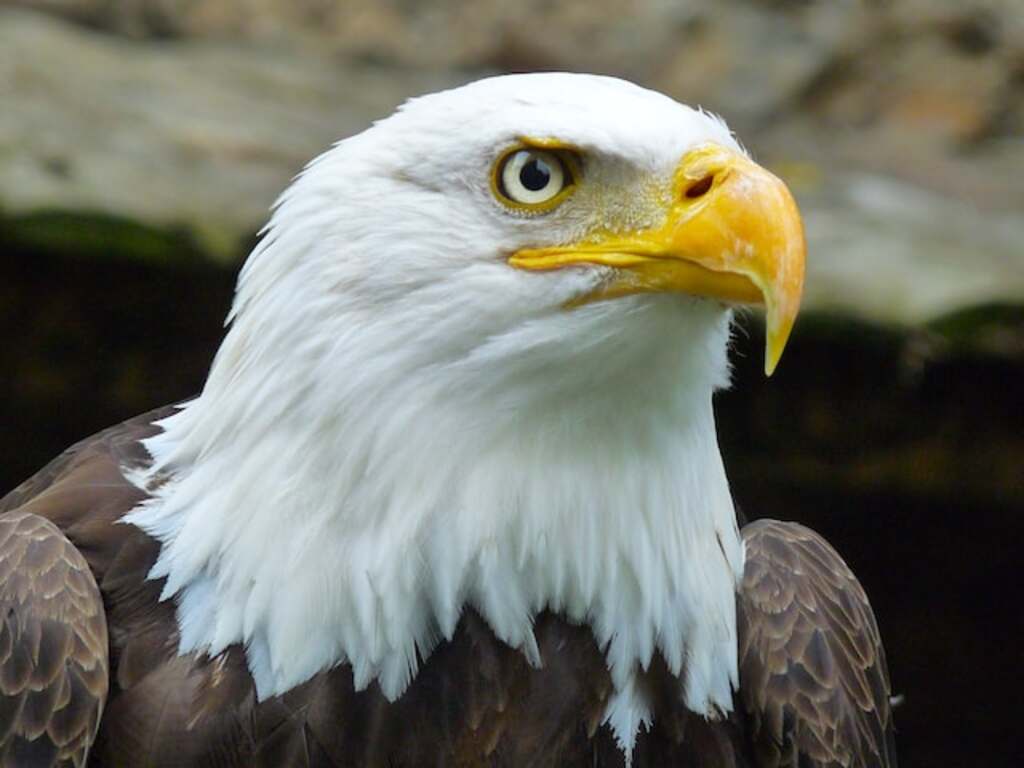
Age and Maturity in Bald Eagles
This discussion focuses on the age and maturity of bald eagles, specifically regarding changes in plumage over time and the development of the white head.
As bald eagles mature, their plumage undergoes distinct transformations. Juvenile eagles have predominantly dark brown plumage, which gradually lightens as they reach adulthood.
Changes in Plumage Over Time
Changes in plumage over time reveal that female bald eagles do not develop a white head, which challenges the popular perception of these majestic birds.
This understanding of evolutionary changes in plumage is crucial in assessing the impact of climate change on the species.
Research shows that the plumage of female bald eagles remains consistently brown, with no transition to the iconic white head observed in males.
This surprising finding challenges the long-held belief that all adult bald eagles develop the characteristic white head.
It prompts us to question the factors that influence the development of this distinguishing feature in males and why it is absent in females.
Understanding the mechanisms behind the development of the white head will provide valuable insights into the biology and behavior of bald eagles.
Development of the White Head
The transformation of the bald eagle’s appearance, specifically the development of a striking white head, is a captivating process that unveils the unique and awe-inspiring characteristics of this iconic bird.
The development of the white head in female bald eagles occurs over several stages, each representing an evolutionary adaptation.
Initially, young female eagles have brown plumage all over their bodies, including their heads.
As they mature, their plumage gradually changes, and by around four to five years of age, they develop the distinct white head that is characteristic of adult bald eagles.
This transformation serves multiple purposes, including signaling maturity and establishing dominance within their population.
The development stages of the white head in female bald eagles highlight the fascinating evolutionary adaptations that have shaped their appearance.
Understanding these processes is crucial in comprehending the importance of individual variation in bald eagle populations.
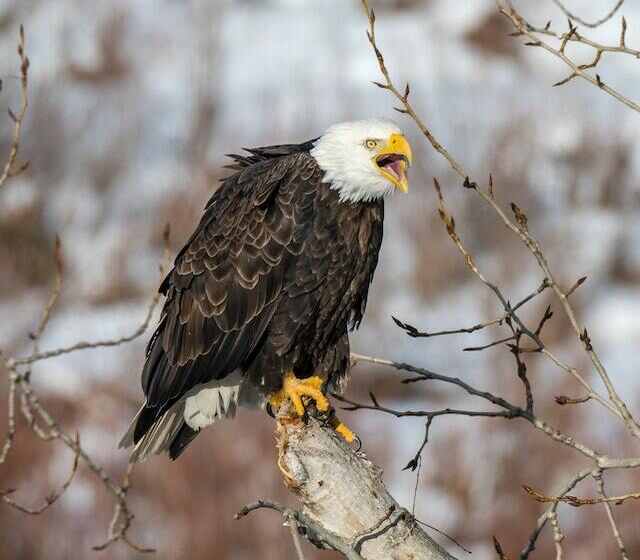
The Importance of Individual Variation
The importance of individual variation in bald eagles cannot be understated, as it plays a crucial role in understanding their unique characteristics and the variation among different populations.
By studying individual variations in traits such as body size, plumage coloration, and beak morphology, researchers can gain valuable insights into the adaptive strategies employed by different populations of bald eagles.
Furthermore, understanding these variations is essential for identifying and conserving different subpopulations of this iconic bird species.
Unique Characteristics in Bald Eagles
Distinctive features of bald eagles include their white head feathers in adulthood. This unique characteristic is highly visible and serves as a key identifying trait for these majestic birds.
The white feathers atop the head create a stark contrast against the dark brown body, enhancing the eagle’s regal appearance.
Furthermore, the white head feathers play a significant role in the mating behaviors of bald eagles.
It is believed that the coloration of the head feathers is an important factor in attracting potential mates, signaling their genetic fitness and overall health.
Interestingly, genetic mutations can occasionally result in bald eagles having a non-white head, which further highlights the significance of this trait.
Understanding the unique characteristics of bald eagles, including their white head feathers, provides valuable insights into their behavior and evolutionary adaptations.
Transitioning into the subsequent section, variation among populations also contributes to the fascinating diversity within this iconic species.
Variation Among Populations
Variation among populations of bald eagles contributes to the captivating diversity within this iconic species, arousing a sense of wonder and appreciation for the intricate genetic adaptations that have allowed them to thrive in different environments.
One notable variation among populations is their migration patterns.
Bald eagles exhibit diverse migratory behaviors, with some populations being resident year-round in their breeding areas, while others migrate long distances to reach their wintering grounds.
This variation in migration patterns is influenced by factors such as food availability, climate, and habitat suitability.
Additionally, the impact of climate change has been observed to affect the migration patterns of bald eagles, with shifts in their distribution and timing being reported.
Understanding these variations in migration patterns is crucial for effective conservation efforts and the preservation of this majestic species.
Observing bald eagles in the wild provides a unique opportunity to witness firsthand their awe-inspiring behaviors and adaptations.
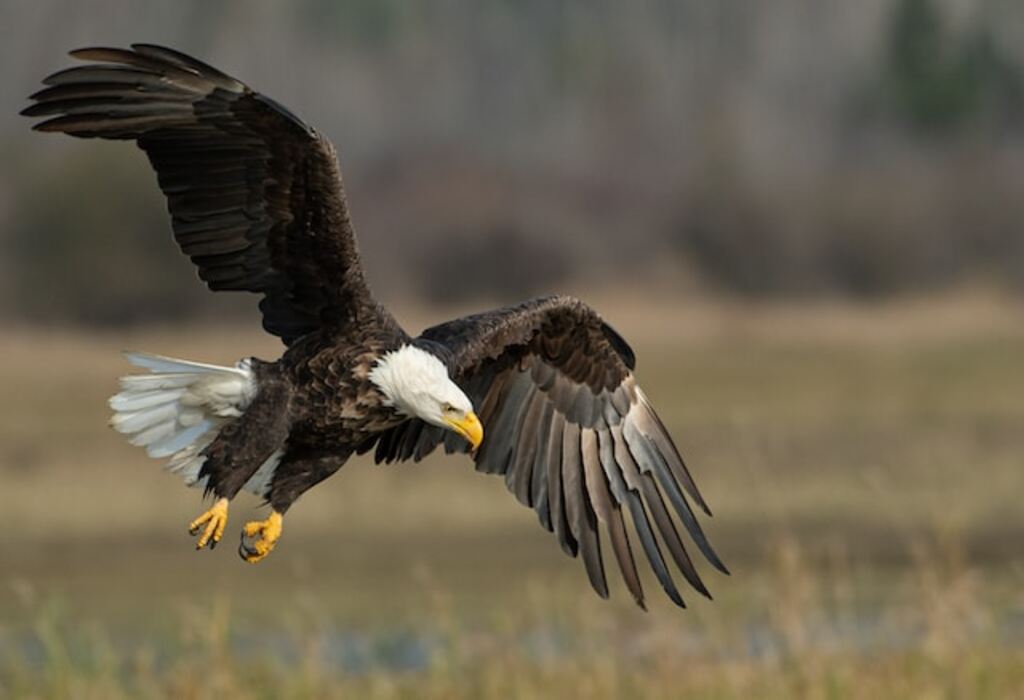
Observing Bald Eagles in the Wild
Birdwatching and conservation efforts play a crucial role in the study and preservation of bald eagles in the wild.
Observing these majestic birds in their natural habitat allows researchers to gather valuable data on their behavior, population dynamics, and habitat requirements.
Additionally, citizen science initiatives provide opportunities for individuals to contribute to ongoing research efforts and expand our understanding of bald eagle biology.
Birdwatching and Conservation Efforts
Conservation efforts in birdwatching have been instrumental in protecting and preserving the habitats of various bird species, including the bald eagle, ensuring their continued existence for future generations.
Birdwatching enthusiasts actively participate in conservation efforts through various means. Here are three key ways in which birdwatching contributes to conservation:
- Habitat preservation: Birdwatchers often collaborate with conservation organizations to identify and protect important bird habitats. By monitoring and reporting bird sightings, they help identify areas that require conservation efforts, such as nesting sites and feeding grounds for bald eagles.
- Public awareness: Birdwatchers play a crucial role in raising public awareness about the importance of conserving bird species and their habitats. They often organize educational events, workshops, and guided tours, promoting a deeper understanding and appreciation for birds.
- Data collection: Birdwatchers contribute valuable data to scientific research. By documenting bird behavior, population trends, and migration patterns, they provide researchers with important insights into the health and conservation status of bird species, including the bald eagle.
Through birdwatching and conservation efforts, researchers and enthusiasts alike have the opportunity to contribute to scientific knowledge and actively participate in the preservation of bird species and their habitats.
This valuable work sets the stage for the subsequent section on citizen science and research opportunities.
Citizen Science and Research Opportunities
Citizen science initiatives provide birdwatchers with valuable research opportunities and allow for the collection of extensive data on bird populations, behaviors, and environmental impacts.
By engaging the public in scientific research, these initiatives empower individuals to contribute to ornithology and conservation efforts.
Citizen scientists can participate in various activities, such as bird counts, nest monitoring, and data recording, which provide crucial information for understanding bird populations and their dynamics.
Moreover, these initiatives enable researchers to study bird behaviors and identify patterns and trends on a larger scale.
The data collected through citizen science projects can be used to inform conservation strategies, monitor the effects of environmental changes, and assess the success of conservation efforts.
Transitioning into the subsequent section about the role of photography in capturing plumage variation, the extensive data collected through citizen science initiatives can also help researchers study the intricacies of bird plumage and understand the factors influencing its variation.
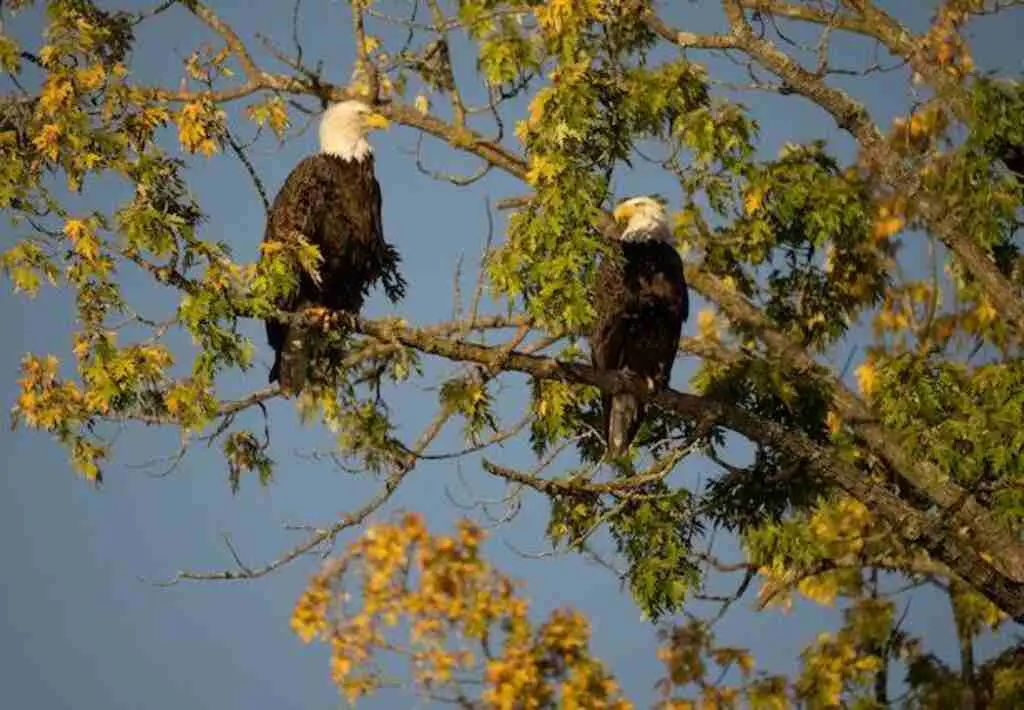
The Role of Photography in Capturing Plumage Variation
Photography has been instrumental in documenting the plumage variation of female bald eagles, revealing that only 25% of them develop the iconic white head commonly associated with this species.
Through various photography techniques, researchers have been able to capture and analyze the diverse plumage patterns exhibited by female bald eagles.
This variation in plumage is believed to be an evolutionary adaptation that allows female eagles to blend into their surroundings while incubating their eggs or caring for their young.
The use of high-resolution cameras and long lenses has enabled scientists to capture detailed images of female bald eagles in their natural habitats, providing valuable insights into their plumage diversity.
By appreciating the diversity of bald eagles’ plumage, we gain a deeper understanding of the adaptive strategies employed by these majestic birds.
This knowledge can help inform conservation efforts and promote the preservation of their habitats for future generations.
Conclusion: Appreciating the Diversity of Bald Eagles’ Plumage
Appreciating the diverse plumage patterns exhibited by female bald eagles allows for a comprehensive understanding of their adaptive strategies in blending into their natural habitats while incubating eggs or caring for their young.
The variation in plumage coloration and patterns among female bald eagles is not only aesthetically pleasing but also serves an important ecological purpose.
Research has shown that the different plumage patterns enable these birds to camouflage themselves effectively within their surroundings, making it easier for them to protect their nests and offspring from potential threats.
Additionally, the diverse plumage of female bald eagles holds cultural symbolism and represents a sense of freedom and resilience.
The striking appearance of these birds has captivated human interest for centuries, and their beauty continues to be celebrated in various forms of art and literature.
By appreciating the diversity of their plumage, we can gain a deeper appreciation for the natural world and the intricate adaptations of these magnificent creatures.
Frequently Asked Questions
How long does it take for female bald eagles to develop a white head?
Factors influencing the development of white head coloration in female bald eagles include age, diet, and hormonal changes. The genetic basis for this coloration is believed to involve specific genes responsible for pigmentation regulation.
Are there any other physical characteristics that distinguish female bald eagles from males, besides the color of their heads?
Physical characteristics that distinguish female bald eagles from males, besides the color of their heads, include body size, beak size, and overall body shape. Females tend to be larger with a longer beak and broader body shape compared to males.
Do all female bald eagles eventually develop a white head, or are there exceptions?
Female bald eagles do not always develop a white head. The change in feather coloration occurs as they reach maturity, typically around 4-5 years of age, but there are exceptions to this pattern.
Are there any environmental factors that can cause female bald eagles to lose their white head coloration?
Environmental factors, such as pollution and habitat degradation, can potentially affect the hormonal changes in female bald eagles, leading to a loss of white head coloration. Further research is required to fully understand these mechanisms.
Can the white head coloration of female bald eagles change throughout their lifetime, or is it permanent once it develops?
The white head coloration of female bald eagles is permanent once it develops, and it does not change throughout their lifetime. It takes about four to five years for female bald eagles to fully develop their white head.

